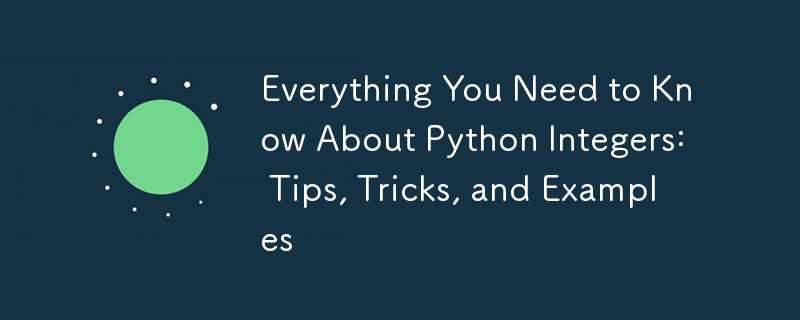Home >Backend Development >Python Tutorial >Everything You Need to Know About Python Integers: Tips, Tricks, and Examples
Everything You Need to Know About Python Integers: Tips, Tricks, and Examples
- DDDOriginal
- 2024-10-09 20:15:28497browse

Python, as a versatile programming language, offers a variety of data types to cater to different needs, with integers being one of the most fundamental. This article provides a detailed look at Python integers, covering their characteristics, operations, and practical examples, making it an essential read for beginners and seasoned developers alike.
What Are Python Integers?
In Python, integers are whole numbers that can be positive, negative, or zero. Unlike other programming languages, Python supports arbitrarily large integers, allowing developers to work with numbers beyond typical limits without needing special libraries or data types.
Creating Python Integers
Creating integers in Python is straightforward. You can assign a whole number directly to a variable:
# Creating integers a = 10 b = -5 c = 0 print(a, b, c) # Output: 10 -5 0
Basic Arithmetic Operations
Python integers support several arithmetic operations, including addition, subtraction, multiplication, and division. Here’s how you can perform these operations:
# Basic operations x = 15 y = 4 addition = x + y # Addition subtraction = x - y # Subtraction multiplication = x * y # Multiplication division = x / y # Division (returns float) floor_division = x // y # Floor Division (returns integer) modulus = x % y # Modulus (remainder) exponentiation = x ** y # Exponentiation print(addition, subtraction, multiplication, division, floor_division, modulus, exponentiation) # Output: 19 11 60 3.75 3 3 50625
Type Checking
To ensure that you are working with integers, you can use the type() function:
# Type checking print(type(a)) # Output: <class 'int'>
Converting Other Types to Integers
Python makes it easy to convert other data types to integers using the int() function. This is particularly useful when dealing with user inputs or data from external sources.
# Converting to integers float_num = 3.14 string_num = "42" converted_float = int(float_num) # Converts float to int converted_string = int(string_num) # Converts string to int print(converted_float, converted_string) # Output: 3 42
Working with Large Integers
One of the standout features of Python is its ability to handle large integers seamlessly. You can create and manipulate integers of any size:
# Large integers large_num = 123456789012345678901234567890 print(large_num) # Output: 123456789012345678901234567890
Useful Integer Methods
Python integers come with several built-in methods. For instance, the bit_length() method returns the number of bits required to represent the integer in binary:
# Integer methods num = 42 print(num.bit_length()) # Output: 6 (because 42 is 101010 in binary)
Practical Example
To illustrate the use of integers in a practical scenario, consider a simple program that calculates the area of a rectangle:
# A simple program to calculate the area of a rectangle
length = 10 # Length of the rectangle
width = 5 # Width of the rectangle
area = length * width # Calculate area
print(f"The area of the rectangle is: {area}") # Output: The area of the rectangle is: 50
Conclusion
Python integers are an essential part of programming, offering flexibility and ease of use for various applications. Understanding how to work with integers will empower you to tackle more complex programming tasks and enhance your coding skills.
The above is the detailed content of Everything You Need to Know About Python Integers: Tips, Tricks, and Examples. For more information, please follow other related articles on the PHP Chinese website!

